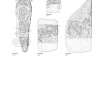Inverurie
Pictish Symbol Stone (Pictish)
Site Name Inverurie
Classification Pictish Symbol Stone (Pictish)
Alternative Name(s) Old Inverurie Churchyard; Inverurie Cemetery; Inverurie No. 1; Inverury No. 1
Canmore ID 18873
Site Number NJ72SE 11.01
NGR NJ 7802 2062
Datum OSGB36 - NGR
Permalink http://canmore.org.uk/site/18873
- Council Aberdeenshire
- Parish Inverurie
- Former Region Grampian
- Former District Gordon
- Former County Aberdeenshire
In 2018, Scheduled Monument Consent approved relocation of SM74 (four symbol stones) to within the grounds of SM99 (Bass and Little Bass Motte) and their housing within a glass case display.
The four Class I Pictish symbols stones were previously located 100m west northwest of their present location and are now in a glass display case on The Bass and Little Bass, motte-and-bailey castle (Scheduled Monument SM99). This is located within Inverurie Cemetery.
The stones are believed to have been previously built into the walls of the old parish church, which stood in the northwest corner of the adjacent cemetery. The kirk went out of use in 1775, its walls were used as a source to construct or repair the dykes of the kirkyard in the early 19th century. Three of the symbol stones were later removed from the dykes and while another was rescued when the walls were being constructed. The four symbol stones are now in a glass display case, known as and arranged (from left to right) as; Inverurie numbers 1, 2, 3 and 4.
Reference (1903)
(Inverury no. 1). A fragment of red granite, of irregular shape, 5ft 9ins (1.75m) by 1ft 6ins (0.46m) by 9ins (0.23m) thick, sculptured with incised lines on one face: front: at the top the crescent and V-rod symbol, below this the mirror-case symbol, then the serpent crossed by the rod symbol, and at the bottom the double disc and Z-rod symbol. The circular part of the mirror-case is ornamented with two concentric circles and a central dot.
J R Allen and J Anderson 1903.
External Reference (1980)
(Inverurie No. 1). This stone measures 1.75m x 0.45m x 0.22m and is of red granite incised with the crescent and V-rod, the mirror case, a serpent crossed by a rod and part of a double disc and Z-rod symbols.
Information from R Jones 1980.
Field Visit (14 August 2000)
(Inverurie no. 1). This Class I symbol stone, which bears a crescent and V-rod, a mirror-case, a serpent and rod, and a double disk and Z-rod, lies horizontally upon two pairs of rectangular blocks. A pink granite slab, it is irregular in shape, and measures 1.76m in length by 0.52m in breadth and 0.36m in thickness. The uppermost symbol is the crescent and V-rod incised at the N end of the upper face, but the right hand edge and terminal of the V-rod is wholly missing, and the left hand terminal, which has a tulip-like expansion and two curlicues, has been mutilated. The crescent is enriched with simple curvilinear decoration and dots, the central portion reminiscent of a motorcycle helmet. Each arm of the crescent contains a single curved line. Below this is the mirror-case symbol, its upper part containing an inner circle with a central dot. The base and sides of the foot are concave and are paralleled by the remains of a less well defined inner quadrangle.
Below this the curving body and tail of the serpent can be seen. The line of the interweaving rod is less deeply incised, but two curlicues on the edge of the stone indicate that this has been a straight rod, rather than the more usual Z-rod. The remainder of the terminal is missing. The portion of the stone bearing the neck and head of the serpent, which was described in Allen and Anderson (1903, p.168, fig. 179), is now also missing.
The double-disk and Z-rod symbol lies below this, but one disk is entirely lost, and only a little over half of the other is preserved. This contains two concentric circles and a central dot. The surviving portion of the bar between the disks has concave sides and is crossed by a Z-rod with bracketed angles.
The presence of four symbols on one face of a Class I stone is unusual. However, it is clear that the serpent and double-disk are more deeply incised than the crescent and V-rod and mirror-case, raising the possibility there are two phases of symbols on the stone. Indeed, the depiction of the head of the serpent recorded by Allen and Anderson indicates that the lower pair of symbols are aligned down in relation to the upper pair. This indicates that the symbol stone inverted and reused at some time, though which pair takes precedence is unclear.
Visited by RCAHMS (IF), 14 August 2000.


























